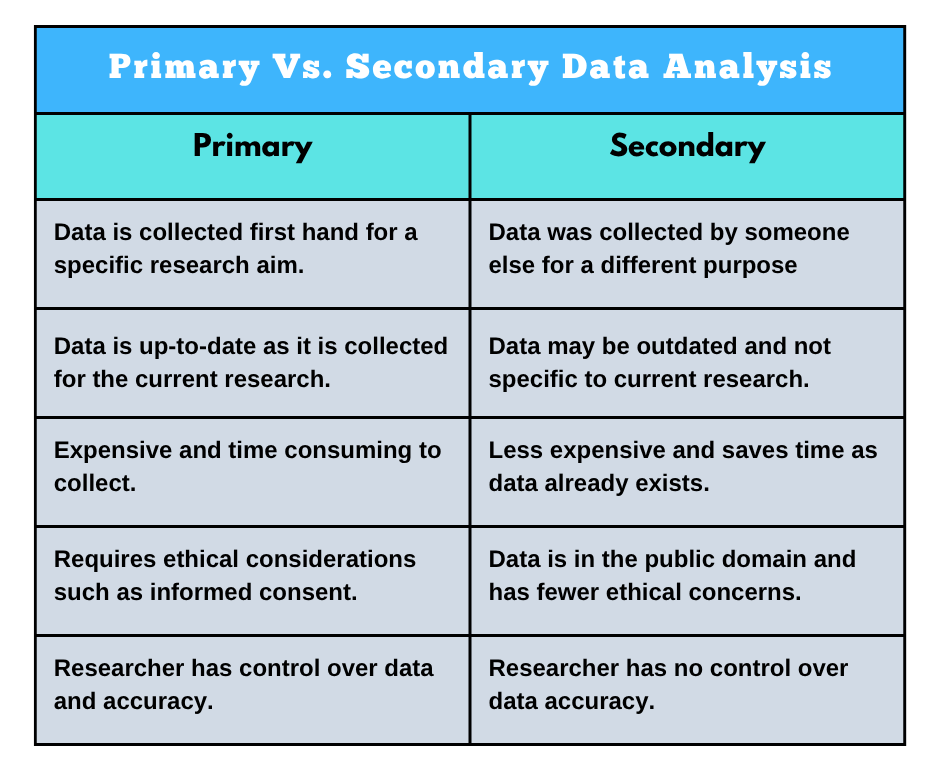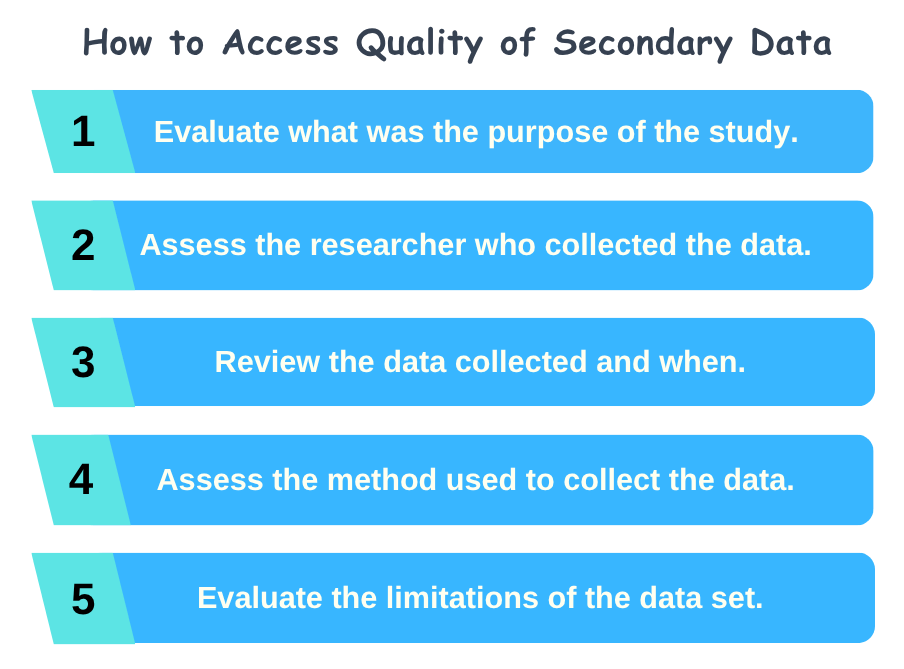Get Expert Help with Secondary Data Analysis
Secondary data analysis involves utilizing data collected for a different purpose to answer new research questions or validate other research findings. By applying a secondary data analysis approach, investigators can optimize the value of existing datasets to identify patterns, trends, and correlations in data, thereby overcoming the monetary and time constraints associated with primary data collection and analysis. For those seeking a secondary data analysis expert, we have highly qualified professionals who help clients with conducting secondary data analysis to test or validate hypotheses, investigate sensitive populations or research areas, and fulfill their research objectives. This article outlines the step-by-step process followed by our experts when conducting secondary data analysis and provides an illustration of secondary data sources.
What is Secondary Data Analysis?
Secondary data analysis involves analyzing existing primary data originally collected for other purposes to make conclusions or develop knowledge in addition to what resulted from the original data analysis. The secondary data analysis approach is mostly applied in the social sciences where the population or studies are sensitive, and ethical constraints may limit the ability to collect primary data. Secondary data analysis methods can be qualitative or quantitative, depending on the nature of the data. Qualitative secondary data analysis methods require careful consideration and a detailed description to enable the researcher to understand and contextualize the results from previous studies. For quantitative secondary data analysis, investigators utilize numerical data collected by researchers to answer research questions, test hypotheses, or validate pre-existing findings.

How to Analyze Secondary Data?
When providing help with secondary data analysis, our specialists follow this step-by-step process to draw valid conclusions from the client’s data:
Step 1: Define Research Objectives
Research objectives are brief statements that illustrate what the investigator aims to achieve by conducting the study. The research objectives should be specific, measurable, and achievable. By defining the research objectives, our experts demonstrate the scope of the study, give direction to the secondary research, and help maintain focus on the topic.
Step 2: Secondary Data Collection
Secondary data is readily available for investigators to utilize for their research. Some of the secondary data collection sources include government reports, international firm reports, journal articles, books, and scholarly university publications, among others. By gathering secondary data, researchers save time and resources that would have been used for primary data collection, gain access to multiple organizations that they may not have been able to collect from, and obtain more credible sources. When you hire our experts to assist with secondary data analysis, we help you evaluate the relevance and credibility of the secondary data by considering factors such as the author’s qualifications, methods employed, publication dates, and potential biases.
Step 3: Preparing Data for Analysis
Data preparation is the systematic process of refining raw data to make it suitable for analysis, thereby achieving accurate and reliable results. Our secondary data analysis expert prepares the data by eliminating outliers and data discrepancies, filling in missing values, removing duplicates, and correcting structural errors. Data preparation enables researchers to identify potential errors that would go undetected and acquire dependable findings.
Step 4: Conducting the Secondary Data Analysis
When conducting secondary data analysis, researchers utilize data analytical methods and statistical software to analyze data and draw meaningful insights. Software tools utilized by researchers to conduct secondary data analysis include SPSS, SAS, Tableau, Minitab, Python, R, NVivo, or MAXQDA, based on the structure of the client’s secondary data. We offer customized secondary data analysis services for qualitative, quantitative, or mixed-methods research.
Step 5: Interpretation
Data interpretation refers to the process of examining and reviewing the findings from secondary analysis to understand the results and draw meaningful conclusions. Our experts interpret the data by understanding the results in the context of the original research objectives, identifying any limitations of the secondary data, and illustrating aspects that may have influenced the findings. By drawing inferences from the data, our clients can answer their research questions, prove hypotheses, or make informed decisions.
Step 6: Reporting
After conducting the analysis, researchers compile detailed reports to illustrate the background of the research, methodology, and findings of the secondary data analysis. The secondary data analysis report typically consists of an introduction, a comprehensive explanation of the data collection and analysis techniques used, results, and a discussion of the findings, implications, and recommendations. For customized secondary data analysis services tailored to your specific aims and objectives, contact our qualified experts today.
Secondary Data Sources in Research
Secondary data is data that is collected to be used for a purpose rather than what it was intended for. By collecting secondary data, investigators can access massive and high-quality databases that would be impractical for an individual researcher to obtain. Secondary data is obtained from a wide range of sources, including information collected by governments, databases owned by scholars and research institutions, survey records, journal articles, books, and records, among others.
Secondary Data Analysis Example
A market researcher at a retail company conducted a secondary data analysis to gain insights into shoppers’ purchasing behaviors, industry patterns, and trends to understand the effects of inflation on consumer behavior. Using consumer price index data acquired from financial institution reports, public sales data, and trend data from various platforms, the investigator noted that consumers were opting for lower-cost items over products from high-end brands. Through the analysis of secondary data, the market researcher assisted business owners in conducting a stock adjustment, updating pricing, and refining their strategies to attract more customers, eliminating the need for primary data collection and analysis.
Benefits of Getting Help with Secondary Data Analysis
Obtaining assistance with secondary analysis from our specialists enables our clients to save time and costs that would have been spent conducting an in-house primary data analysis. By utilizing readily available data, we help our clients avoid expenses associated with recruiting participants for the study and acquiring collection instruments.
Secondary data obtained from government publications and official documents is usually available in massive volumes and depth. By seeking assistance with secondary analysis from our professionals, clients can evaluate and understand the patterns, trends, and changes in phenomena over a long period.
By utilizing existing databases when conducting secondary analysis, we enable clients to access data that would have been challenging to collect. We utilize previously collected data to help customers with studies that involve comparing multiple sources of data.
Secondary data gathered from credible sources such as government publications are more reliable and precise because they are written by experts who draw information from various sources.

Why Hire a Secondary Data Analysis Expert from Our Company?
Our company has the best subject matter experts from different fields of research with extensive background experience in conducting secondary data analysis.
When selecting statisticians and analysts for providing secondary data analysis services, we choose skilled experts with advanced degrees in fields such as statistics, computer science, mathematics, social sciences, and data science. With our expertise, we provide exceptional assistance with conducting both simple and advanced secondary data analysis studies, delivering accurate and reliable results.
Our customer support team is available 24/7, allowing us to respond promptly to clients’ inquiries and provide solutions in real time.
Professionals from our company work within the client’s specified timeframe to deliver results on time, even under tight deadlines.
When clients choose us for assistance with secondary data analysis, we utilize our analytical skills and advanced analysis software tools, including SPSS, R, Python, STATA, NVivo, and MAXQDA, to analyze data.
Summary
Secondary data analysis involves using previously collected data to answer a research question. There are several sources of secondary data that researchers can use to obtain information, including government sources such as censuses, education databases, and non-government databases like general social surveys. Utilizing these sources can help one make meaningful conclusions for their research. Are you looking for help with secondary data analysis? Contact us today for inquiries, and you will get a response almost immediately to get started.